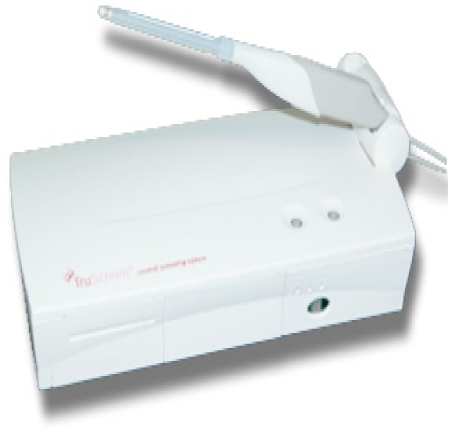Korean J Obstet Gynecol.
2010 Oct;53(10):888-893. 10.5468/kjog.2010.53.10.888.
The efficacy of a real-time optoelectronic device as a diagnostic tool of over cervical intraepithelial neoplasia 1 lesion
- Affiliations
-
- 1Department of Obstetrics and Gynecology, Seoul National University College of Medicine, Seoul, Korea. ksboo308@plaza.snu.ac.kr
- KMID: 1453753
- DOI: http://doi.org/10.5468/kjog.2010.53.10.888
Abstract
OBJECTIVE
The purpose of this study was to evaluate the sensitivity, specificity and accuracy of a real-time optoelectronic device (TruScreen) as a diagnostic tool of cervical intraepithelial neoplasia (CIN) or cervical cancer.
METHODS
Two hundred ninety two patients who had been presented with previously abnormal Papanicolaou (Pap) smear or abnormal colposcopic findings between February 2009 and September 2009 were analyzed. The sensitivities, specificities and accuracies of TruScreen and liquid-based cytology were evaluated.
RESULTS
As a diagnostic tool of CIN, carcinoma in situ (CIS), and cervical cancer, TruScreen appeared sensitive enough compared with liquid-based cytology (82.8% vs 75.9%), but the difference is statistically not significant (P=0.687). Specificity and accuracy of TruScreen were similar to those of liquid-based cytology (specificity 81.4% vs 83.3%, accuracy 81.5% vs 82.5%).
CONCLUSION
The present study suggests that the TruScreen could be an option as a tool of screening test in CIN, CIS, and cervical cancer and also be used combined with Pap smear.
MeSH Terms
Figure
Reference
-
1. Ministry for Health, Welfare and Family Affairs. Annual report of cancer incidence (2007), cancer prevalence (2007) and survival (1993-2007) in Korea. 2009.2. Shafi MI, Welton K. Colposcopy and cervical intraepithelial neoplasia. Obstet Gynaecol Reprod Med. 2007. 17:173–180.3. Richart RM. Natural history of cervical intraepithelial neoplasia. Clin Obstet Gynecol. 1967. 10:748–784.4. Papanicolaou GN, Traut HF. The diagnostic value of vaginal smears in carcinoma of the uterus. 1941. Arch Pathol Lab Med. 1997. 121:211–224.5. Nanda K, McCrory DC, Myers ER, Bastian LA, Hasselblad V, Hickey JD, et al. Accuracy of the Papanicolaou test in screening for and follow-up of cervical cytologic abnormalities: a systematic review. Ann Intern Med. 2000. 132:810–819.6. Cuzick J, Clavel C, Petry KU, Meijer CJ, Hoyer H, Ratnam S, et al. Overview of the European and North American studies on HPV testing in primary cervical cancer screening. Int J Cancer. 2006. 119:1095–1101.7. McCaffery K, Waller J, Nazroo J, Wardle J. Social and psychological impact of HPV testing in cervical screening: a qualitative study. Sex Transm Infect. 2006. 82:169–174.8. Mould TAJ, Quek SC, Lovegrove J, Gallivan S, Singer A. The acceptability of cytological screening for cervical cancer compared to a new electronic screening device-the Polarprobe. 1997. In : Proceedings of the EUROGIN Third International Congress; 1997 March 24-27; Paris. Paris. European Research Organization on Genital Infection and Neoplasia.9. Coppleson M, Canfell K, Skladnev V. The Polarprobe: an instantaneous optoelectronic approach to cervical screening. CME J Gynecol Oncol. 2000. 5:31–38.10. Lee SK, Kim SY, Chung HW, Lee HH, Nam KH, Lee KH. The use of papanicolaou smear and cervicography in screening test of cervical cancer. Korean J Obstet Gynecol. 1998. 41:424–432.11. Koliopoulos G, Arbyn M, Martin-Hirsch P, Kyrgiou M, Prendiville W, Paraskevaidis E. Diagnostic accuracy of human papillomavirus testing in primary cervical screening: a systematic review and meta-analysis of non-randomized studies. Gynecol Oncol. 2007. 104:232–246.12. De Alba I, Anton-Culver H, Hubbell FA, Ziogas A, Hess JR, Bracho A, et al. Self-sampling for human papillomavirus in a community setting: feasibility in Hispanic women. Cancer Epidemiol Biomarkers Prev. 2008. 17:2163–2168.13. Gravitt PE, Lacey JV Jr, Brinton LA, Barnes WA, Kornegay JR, Greenberg MD, et al. Evaluation of self-collected cervicovaginal cell samples for human papillomavirus testing by polymerase chain reaction. Cancer Epidemiol Biomarkers Prev. 2001. 10:95–100.14. Ogilvie GS, Patrick DM, Schulzer M, Sellors JW, Petric M, Chambers K, et al. Diagnostic accuracy of self collected vaginal specimens for human papillomavirus compared to clinician collected human papillomavirus specimens: a meta-analysis. Sex Transm Infect. 2005. 81:207–212.15. Singer A, Coppleson M, Canfell K, Skladnev V, Mackellar G, Pisal N, et al. A real time optoelectronic device as an adjunct to the Pap smear for cervical screening: a multicenter evaluation. Int J Gynecol Cancer. 2003. 13:804–811.16. Lee SJ, Bae JH, Kim JH, Lee SH, Namkoong SE, Park JS. A real-time optoelectronic device in screening of cervical intraepithelial neoplasia. J Womens Med. 2009. 2:23–28.17. Siebers AG, Klinkhamer PJ, Grefte JM, Massuger LF, Vedder JE, Beijers-Broos A, et al. Comparison of liquid-based cytology with conventional cytology for detection of cervical cancer precursors: a randomized controlled trial. JAMA. 2009. 302:1757–1764.18. McIndoe GA, Robson MS, Tidy JA, Mason WP, Anderson MC. Laser excision rather than vaporization: the treatment of choice for cervical intraepithelial neoplasia. Obstet Gynecol. 1989. 74:165–168.19. Skehan M, Soutter WP, Lim K, Krausz T, Pryse-Davies J. Reliability of colposcopy and directed punch biopsy. Br J Obstet Gynaecol. 1990. 97:811–816.20. Choi KJ, Nam KH, Sim JH, Lee IS, Lee KH, Kim DW. Efficacy of loop electrosurgical excision procedure (LEEP) in the correlation between colposcopically directed punch biopsy and LEEP. Korean J Obstet Gynecol. 1997. 40:2246–2252.
- Full Text Links
- Actions
-
Cited
- CITED
-
- Close
- Share
- Similar articles
-
- Pathological and statistical studies of koilocytosis in the cervical intraepithelial neoplasia
- A Case of Epidermodysplasia Verruciformis with Cervical and Vulvar Intraepithelial Neoplasia
- Comments on: a phase 1/2a, dose-escalation, safety and preliminary efficacy study of oral therapeutic vaccine in subjects with cervical intraepithelial neoplasia 3
- Mapping Study of Cervical Intraepithelial Neoplasia III in Uterine Cervix
- HPV DNA test as a Diagnostic Tool for Cervical Cancer


